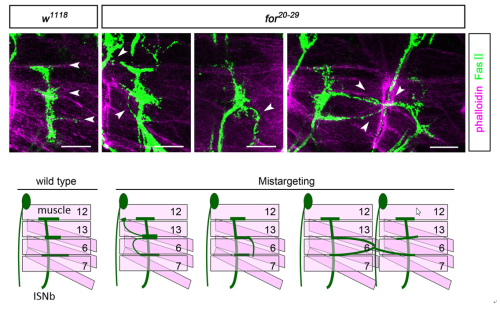Research uncovers the molecular mechanism of cGMP-dependent protein kinase in regulating the motor axon guidance
In a collaboration between the groups of Prof. Li Liu and Prof. Renjie Jiao at Institute of Biophyscics of Chinese Academy of Sciences, it was found that cGMP-dependent protein kinase (PKG) cooperates with transcription factor Lola to regulate the motor axon guidance in Drosophila. This study entitled “cGMP-dependent protein kinase encoded by foraging regulates motor axon guidance in Drosophila by suppressing Lola function” was published in The Journal of Neuroscience on April 20, 2016.
In a complex nervous system, the neural connectivity is established and plays important roles in the input and output of the information. During development, neurons finally meet and mate with their synaptic partners, however, the molecular mechanism underlying the direction of growth and target recognition remains to be clarified. The Drosophila neuromuscular system is a well-characterized model system for axon targeting. At the late embryonic stage, ISNb motor axons extend to the ventral longitudinal muscles and establish three initial synaptic contacts with their target muscles.
This study reveals a novel function of cGMP-dependent protein kinase encoded by foraging (for) in regulating ISNb motor axon guidance in Drosophila. In for mutants, ISNb axons display targeting defects, such as muscle target recognition errors or abnormal associations with other motor axons. These targeting defects of ISNb axons in for mutants were rescued by the overexpression of neuronal PKG. Moreover, knockdown of for in the neurons leads to the similar targeting defects to those observed in for mutants. Through genetic screening, gene lola was found to antagonize for function in ISNb motor axon guidance. In molecular level, PKG physically associates with the LolaT isoform via the C-terminal zinc-finger-containing domain. Overexpression of PKG leads to the cytoplasmic retention of LolaT in S2 cells. Together, this study highlights a new function of PKG in axon guidance by suppressing a transcription factor, which suggests a molecular basis of the formation of neural connectivity in mammals.
Qionglin Peng, Yijin Wang and Meixia Li are co-first authors of this paper. Prof. Li Liu and Prof. Renjie Jiao are the corresponding authors. This work is supported by the Strategic Priority Research Program B of the Chinese Academy of Sciences, the Ministry of Science and Technology of China, the National Natural Sciences Foundation of China.
Figure1. for is required for proper ISNb motor axon pathfinding and target recognition. In w1118 control embryos,ISNb axons innervate appropriate muscles and form three neuromuscular junctions; In for mutant embryos,ISNb axons exhibit different targeting defects.
CONTACT:
Li Liu or Renjie Jiao
Institute of Biophysics, Chinese Academy of Sciences
Beijing 100101, China
Phone: 86-10-64889870 or 86-10-64888406
Email: liuli@ibp.ac.cn or rjiao@ibp.ac.cn


